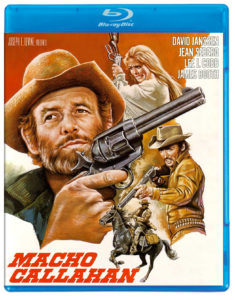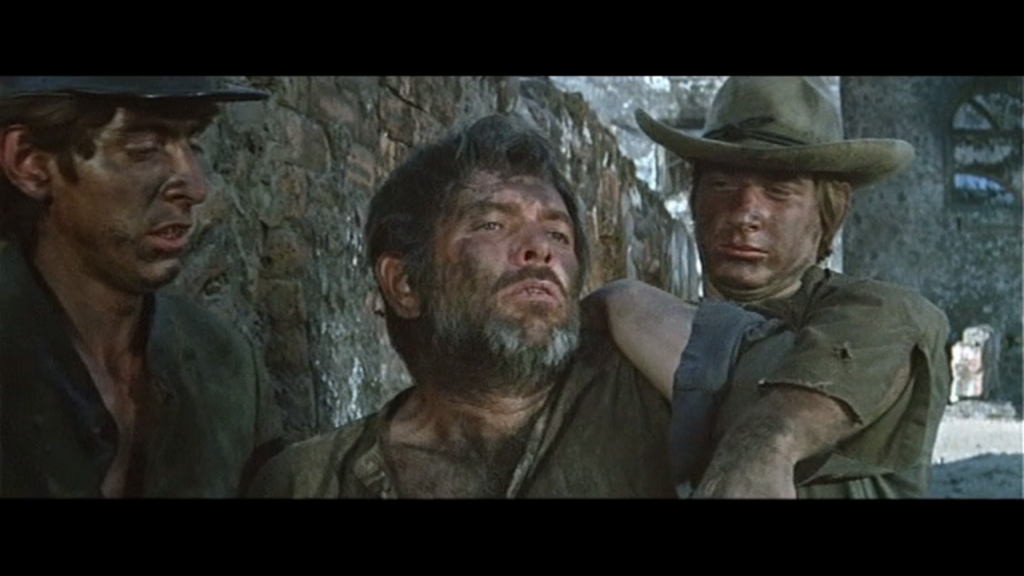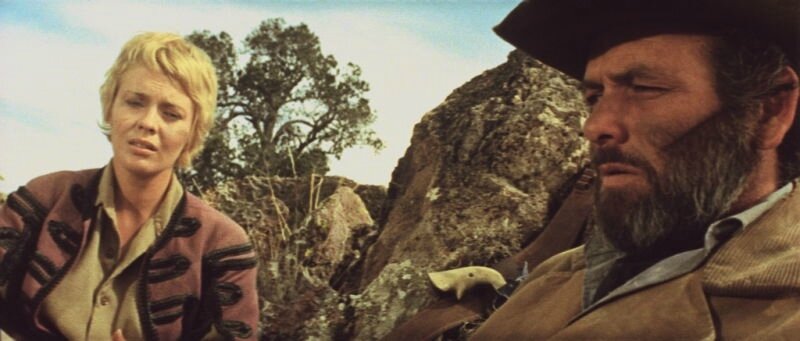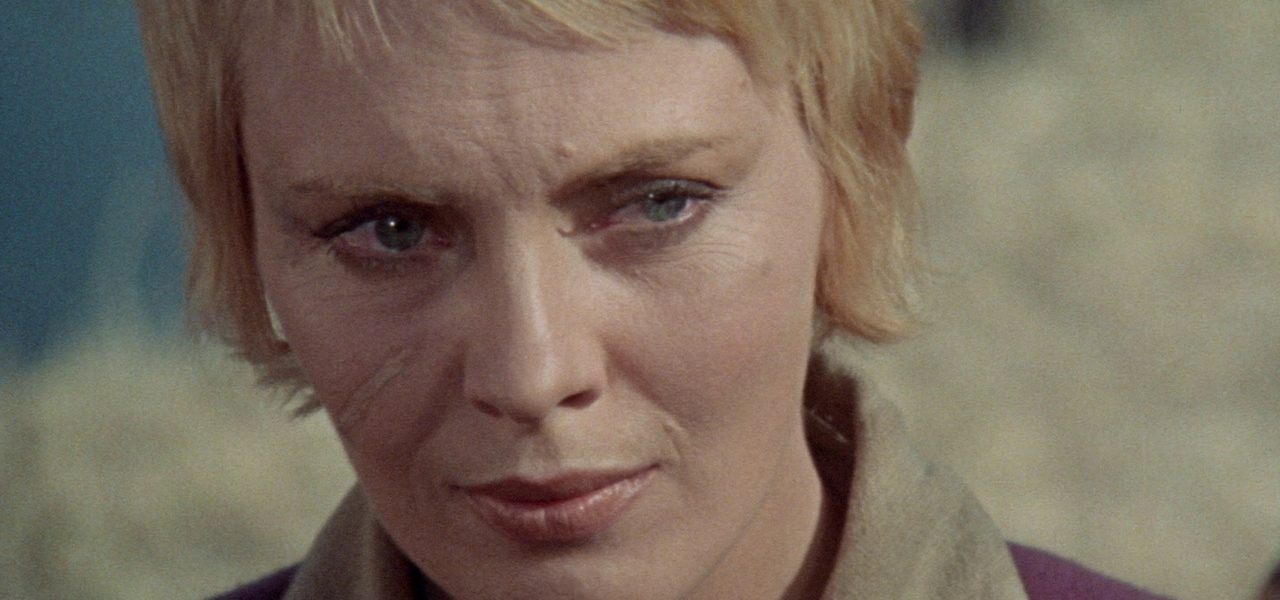Jean Seberg Purues David Janssen’s Insidious Western Antihero
DIRECTED BY BERNARD L. KOWALSKI/1970
BLU-RAY STREET DATE: SEPTEMBER 21, 2021/KL STUDIO CLASSICS
This review discusses narrative aspects of the film’s third act.

For the uninitiated, a title like “Macho Callahan” might evoke expectations of some sort of lightweight Western comedy, ala Texas Along the River or Man of the East. Lock away any such notion.
Set amid the Civil War and fully committed to rendering the American West as an unforgiving hellscape, Macho Callahan is nothing short of utterly harsh and hard-hearted, a portrait of unrelenting filth without fury. If a long-enough bracket exists, one could be justified in classifying Macho Callahan as a female-centric American revisionist Western Neo-Noir. Or, as filmmaker/film historian Alex Cox (Sid & Nancy; Straight to Hell; Highway Patrolman) dubs it on his included constructively critical audio commentary track, a kind of “Neo-Western”.
One needn’t hear Cox’s repeated underlining that Macho Callahan is an American-produced spin on the then-popular Italian Western form to quickly understand its aspirations. The violence is brutal and bloody, heading up what would be a trend in Hollywood Westerns for at least the next three years. If Sergio Leone set out to upend America’s own frontier mythmaking while also paying a kind of homage to it, then this boomeranging stateside wave usurps what that form became via its seminal callous Italian hits such as Sergio Corbucci’s Django. Between that influence and the debatably bigger impact of “Bloody Sam” Peckinpah’s 1968 landmark Western, The Wild Bunch, America’s original film genre soldiered into the blue of moral and even ethical night. Or, more simply put, what goes ‘round comes ‘round… perhaps degradation is to be expected.
The title character (David Janssen, TV’s The Fugitive) is introduced as a bloodthirsty, bullying terror of a man, coldly gunning down the heroine’s new husband (David Carradine, on and done) over a bottle of champagne. We’re more or less stuck with his horrendous visage the entire movie. Alex Cox calls Janssen’s Callahan “The least attractive, most unpleasant Western hero of them all”- which is really saying something, coming from the extraordinary well-versed author of the Italian Western history book, 10,000 Ways to Die. The fact that Callahan earned himself a long torturous stretch in a very small, sanity-destroying isolation box for being a Southern objector to the Confederate cause does nothing to redeem him in our eyes. He’s released from his “hot box” as the movie begins. The neighboring captives tumble out either dead or having gone mad. Callahan is a muttering grimy mess, but he walks away… soon to kill Carradine.

With her wedded bliss shattered, Carradine’s character’s wife, the now-widowed Alexandra Mountford (Jean Seberg, of Godard’s Breathless) offers a steadily increasing reward for the killing of Diego “Macho” Callahan. It is Alexandra, a well-to-do letter writer for the illiterate local cowpokes, who is actually the film’s main character. Over the course of the film, she undergoes a most unsettling arc. This is the result of falling in with the traveling Callahan and his better-minded cohort (Pedro Armendariz Jr.), initially to get even, but later for altogether different reasons.
Alexandra’s failed attempt at revenge gives way to a truly nightmarish rape scene. It’s visually shocking; the kind of dark impressionism more at home in a horror film. This leads to a tremendously problematic twist in which Alexandra falls for Macho in the literally scaring aftermath. There’s Stockholm Syndrome, and then there’s this. Being that Alexandra is at least twice the fleshed-out character that Macho is, the film invites analysis through a female filter. But try as one might, it’s all but impossible to deduce any agency for Alexandra in her third-act decisions.
Adorning the central unpleasantries, Macho Callahan is not without some degree of animal cruelty. A cockfight is glimpsed, a horse is shot (hopefully not really), and the film opens with a cutaway of a guy scooping the intestines out of an actual dead horse. This as the Confederate precursors to Monty Python’s “Bring out your dead!” cart makes its rounds, bleakly collecting stripped infantry corpses.

For all of its morbidity and miserabilism, Macho Callahan can be, visually, a genuinely beautiful film. The landscape displays a country as beautiful as it is roughshod. Director Bernard L. Kowalski (Krakatoa: East of Java) demonstrates a solid visual sense, realized via the great talents of production designer Ted Marshall (art director on Terence Fisher’s sea-change horror film The Curse of Frankenstein) and cinematographer Gerry Fisher (known for shooting the similarly palated Ned Kelly, among other Tony Richardson films). Vitally, Macho Callahan was shot in the careening vastness of the Mexican desert. Cox points out that several of the familiar locations were previously used by Peckinpah in The Wild Bunch. The film’s bleak, oppressively earthy aesthetics, although ultimately less justified as far as the story they’re in service of, are a major part of what makes Macho Callahan worthwhile. Likewise, KL Studio Classics’ presentation of the film’s 4K restoration from the original camera negative makes the new Blu-ray worthwhile.
The cast is another reason. The iconic and then-controversial Seberg is perfect in her role of a woman done wrong trying to navigate her sense of justice. It’s believable that her letter writing profession flourished just because the menfolk enjoyed an audience with her. It’s terribly too bad that she essentially gives in following Callahan’s gross assault on her. Janssen as Callahan is both an ideal choice and a weird choice. Audiences may well not have been expecting to see this recognizable protagonist of television as such a massive bastard. He plays the character’s rotten side well- a Western “man with a code”, but unclear on what that code is. Lee J. Cobb, always a treat, is in the film for a time as “The Man with Yellow Shoes”, the guy Callahan hates the most.
Macho Callahan is both frustrating for its deflating qualities and accomplished enough as a flawed but apt example of its type of American effort prime within Cox’s Vietnam era “Neo-Western” branding. It’s all enough to make any serious collector of Western films cry “Macho!!”.


